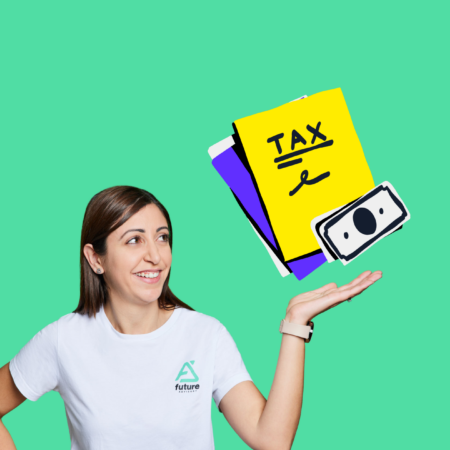Div 293 Tax Explained: What It Is and How to Manage It
Learn what Division 293 tax is, who it affects, how it’s calculated, and smart strategies to manage or reduce your Div 293 tax liability.
What Is Division 293 Tax? Why High-Income Earners Get It
What is Division 293 (Div 293) tax?
Division 293 is an extra 15% tax that reduces the concessional tax break on super for high-income earners. Normally, when your employer puts money into your super (the compulsory 11.5% Super Guarantee, increasing to 12% from July 2025), it gets taxed at a nice low rate of 15%. But if you’re earning above a certain threshold, the government wants to even the playing field a bit.
Here’s how it works:
- If your Division 293 income (broadly your taxable income, plus things like reportable fringe benefits and net investment losses) combined with your concessional super contributions exceeds $250,000, you’ll cop an extra 15% tax.
- But here’s the kicker, it’s not just a flat tax on everything over the threshold. The tax applies to whichever is lower: either (a) the amount over $250,000, or (b) your total concessional super contributions. That brings the total tax on the affected portion up to 30%.
Who gets hit with Division 293?
Anyone whose Division 293 income plus concessional super contributions adds up to over $250,000 in a financial year. Your Division 293 income broadly includes your taxable income, reportable fringe benefits, and total net investment losses (with specific adjustments per the ATO). Then you add your concessional contributions on top to see if you’re over the line.
How much is the Div 293 tax?
If you’re over the threshold, the extra tax is 15%, but it applies to the lesser of either the amount over $250,000 or your total concessional contributions.
Here’s an example to make it crystal clear:
- Your Division 293 income (for tax purposes) is $240,000
- Your employer pays $27,600 into your super as Super Guarantee (at 11.5%)
- That’s $27,600 in concessional contributions
- Combined total: $267,600 (exceeding $250,000 by $17,600)
- Div 293 applies to the lesser of $17,600 and $27,600 → so $17,600
- Your Div 293 tax = 15% × $17,600 = $2,640
(Note: From 1 July 2025, SG becomes 12%, so these numbers will shift slightly.)
What counts as concessional contributions?
These include your employer’s Super Guarantee payments, any salary sacrifice amounts, and personal super contributions you claim as a tax deduction (subject to the concessional cap of $30,000 from 1 July 2024). After-tax or non-concessional contributions don’t trigger Div 293.
Do you have to do anything?
The ATO will send you a Division 293 notice once they’ve processed your tax return and super contribution data (your accountant gets a copy too). Here’s where timing matters:
- Payment is due within 21 days of the notice being issued
- You can pay it yourself directly to the ATO, or
- You can elect within 60 days to have your super fund release the money using a release authority
Here’s the catch: even if you choose the fund release option, the 21-day due date still applies. That means if you wait, interest can start ticking over. It’s worth thinking about your cash flow before you decide.
We can help you figure out the best option based on your situation and retirement goals.
A quick note on the concessional cap
From 1 July 2024, the concessional contributions cap is $30,000 per year. Going over this cap is a separate issue (you’ll cop excess concessional contributions tax), but it can interact with Div 293. Staying under the cap doesn’t automatically mean you’ll dodge Div 293; it all depends on your total income. If you’re juggling both, it’s worth having a chat with us to work out the sweet spot for your super strategy.
How to Pay Div 293 Tax: Super vs. Out-of-Pocket
The ATO usually sends you a notice (and your accountant gets one too). You’ve got options:
- Pay it yourself directly to the ATO
- Elect to have it paid from your super fund (this is called a release authority)
We can help you figure out the best option based on your cash flow and goals.
Why Does Division 293 Tax Exist?
Basically, it’s designed to make the super system fairer. High-income earners get a bigger tax benefit from that concessional 15% rate (because they’d otherwise be paying up to 47% on that income), so Div 293 helps level the playing field compared to middle-income Australians.
Div 293 Strategy: How to Plan Ahead and Avoid Surprises
Division 293 tax isn’t exactly welcome news, but it means you’re earning a great salary, a good problem to have! That said, it’s worth reviewing your super contributions strategy and talking to your accountant about whether adjusting salary sacrifice arrangements, timing bonuses differently, or exploring other planning moves might help manage the impact.
Need help navigating it all? Get in touch – we’re here to make tax just that little bit less taxing.
FAQs About Division 293 Tax
1. What is Division 293 tax?
Division 293 is an extra 15% tax that reduces the concessional tax break on superannuation for high-income earners. It kicks in when your Division 293 income (broadly your taxable income, plus things like reportable fringe benefits and net investment losses) combined with your concessional super contributions, exceeds $250,000 in a financial year. Here’s the kicker: the tax is 15% of whichever is lower, either (a) the amount over $250,000, or (b) your total concessional super contributions. If you’re scratching your head over whether this affects you, our tax and compliance team can walk you through it.
2. What is Div 293 tax and how does it work?
Div 293 tax is triggered when your Division 293 income (taxable income plus adjustments like reportable fringe benefits), combined with your concessional super contributions, goes over $250,000 in a financial year.
The tax applies to the lesser of either the amount over the threshold or your total concessional contributions, then you cop an extra 15% on that figure, bringing the total super tax to 30%. We can walk you through this as part of our tax and compliance service.
3. How to avoid Division 293 tax?
Avoiding Division 293 tax completely may not be possible if your income consistently exceeds the threshold, but there are ways to reduce its impact. You can review salary sacrifice arrangements, manage the timing of bonuses or fringe benefits, or explore whether a different business structure may be more tax-effective. Our business advisory service can help you assess the best options for your situation.
4. Is it better to pay Div 293 from super?
You have two options to pay Div 293 tax: directly to the ATO or from your super fund using a release authority. Paying from super protects your cash flow, while paying out of pocket helps keep more money in your super for retirement. The right choice depends on your financial goals and cash position. Our team can guide you through the pros and cons.
5. What are Division 293 super contributions?
Division 293 tax only applies to concessional super contributions. These include your employer’s Super Guarantee payments, salary-sacrificed amounts, and personal contributions you claim as a tax deduction (subject to the concessional cap of $30,000 from 1 July 2024). After-tax or non-concessional contributions aren’t affected. If you’re unsure how your contributions are tracked, our Xero accounting support can help you stay on top of it.
6. Who pays Div 293 tax?
Anyone with a combined income and concessional super contributions above AUD 250,000 in a financial year may be liable for Div 293 tax. This includes high-income employees, business owners, and professionals who receive bonuses or fringe benefits that push them over the threshold.
7. When do you have to pay Division 293 tax?
After the ATO processes your tax return and super contributions, they’ll issue a Division 293 notice.
Here’s what you need to know about timing: payment is due within 21 days of the notice. You can pay it yourself, or within 60 days, you can elect to have your super fund release the money, but heads up, the 21-day due date still applies, so interest can start ticking if you wait on the release. If you’re concerned about managing payments or timing, our tax payment plan support may be useful.
8. Can the Division 293 tax be refunded?
Generally, Division 293 tax is not refundable once paid, unless your income is amended below the threshold or an error was made in calculation. If you have a situation where your income or super data is being corrected, speak to your accountant to assess whether a refund may be possible.
9. What about the concessional contributions cap?
The concessional contributions cap is $30,000 from 1 July 2024. Going over this cap is a separate issue (you’ll cop excess concessional contributions tax), but it can interact with Div 293. Staying under the cap doesn’t automatically mean you’ll avoid Div 293; it depends on your total income. If you’re juggling both issues, our team can help you work out the sweet spot for your super strategy.
10. How is Division 293 tax calculated?
Your Division 293 tax is calculated by adding your Division 293 income (taxable income plus adjustments like reportable fringe benefits and net investment losses) to your concessional super contributions. If this combined figure exceeds $250,000, the tax is 15% of whichever is lower: (a) the amount over $250,000, or (b) your total concessional contributions.
For example:
- Say your Division 293 income is $240,000 and your Super Guarantee (at 11.5%) adds $27,600 in concessional contributions.
- Combined, that’s $267,600, exceeding $250,000 by $17,600.
- Div 293 applies to the lesser of $17,600 and $27,600, which is $17,600.
- So your Div 293 tax is 15% × $17,600 = $2,640.
- (Note: From 1 July 2025, SG becomes 12%.)
11. Do one-off events affect Division 293 tax?
The ATO will issue a Division 293 notice once your income tax and super data are processed. This will be sent via MyGov or your tax agent. You’ve got two payment options:
- Pay the ATO directly within 21 days
- Elect within 60 days to have your super fund release the money using a release authority.
Just remember, even if you choose the fund release option, the 21-day due date still stands, so interest can start accumulating if you wait. Both options are outlined in the notice with clear instructions. We can help you decide which payment method works best for your cash flow and retirement goals.
12. What payment options do I have for Division 293 tax and how will the ATO notify me?
The ATO will issue a Division 293 notice once your income tax and super data are processed. This will be sent via MyGov or your tax agent. You can pay the tax directly to the ATO or request your super fund to pay it on your behalf using a release authority. Both options are outlined in the notice with clear instructions. We can help you decide which payment method is most appropriate for your situation.
13. Do employers need to prepare for Division 293 tax?
While the tax is applied to individuals, employers still have responsibilities. Making sure super contributions are paid on time, reported accurately and include all relevant salary packaging is essential. This helps employees avoid errors in their Division 293 assessments. Our accounting and bookkeeping services ensure your payroll and super obligations are managed smoothly.
A note for defined benefit members:
If you’re in a defined benefit super fund, special rules apply; Div 293 may be deferred until you access your benefit. It’s not common, but worth checking if this applies to you. Give us a shout if you’re unsure.













